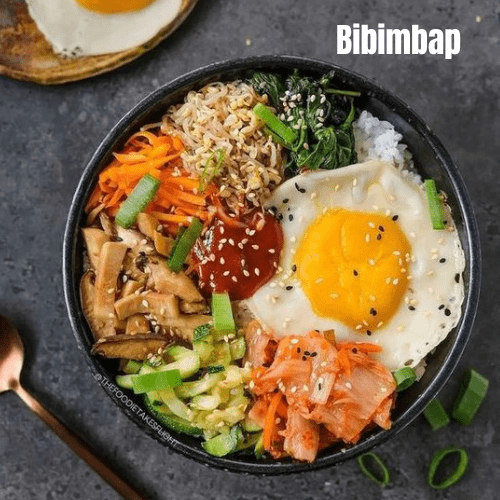Bibimbap, a beloved Korean dish, combines vibrant flavors, textures, and colors into a single bowl. This iconic dish is not just a meal but a feast for the senses, offering a delightful harmony of ingredients.
Ingredients
- 2 cups cooked short-grain rice
- 1 cup assorted vegetables (spinach, carrots, zucchini, mushrooms)
- 1 cup protein (beef bulgogi, tofu, or chicken)
- 4 eggs
- Bibimbap sauce (gochujang-based)
- Sesame oil
- Sesame seeds
- Kimchi (optional, for serving)
- Salt and pepper
Steps:
- Preparing the Rice:
- To start, cook the short-grain rice according to the package instructions until it’s fluffy and sticky. Short-grain rice is preferred for its texture, which helps bind the ingredients together. Once cooked, set the rice aside to cool slightly while you prepare the other components of the dish.
- Cooking Vegetables and Protein:
- Begin with the vegetables by blanching spinach until it’s just wilted, then squeeze out excess water and season lightly with salt and sesame oil for added flavor. Julienne the carrots for a crisp texture and sauté them briefly until tender-crisp. Similarly, slice the zucchini and mushrooms, sautéing each with a touch of sesame oil and seasoning to enhance their individual flavors. For the protein component, whether using beef bulgogi, tofu, or chicken, ensure it’s cooked thoroughly and seasoned to taste with salt and pepper. Keeping these elements separate allows for a colorful and vibrant presentation in the final dish.
- Assembling Bibimbap:
- To assemble the Bibimbap, start with a base layer of the cooked short-grain rice evenly divided among serving bowls. Arrange the cooked vegetables and protein in separate sections on top of the rice, creating a visually appealing display of colors and textures. Next, fry the eggs sunny-side-up or over-easy until the whites are set and the yolks remain slightly runny. Place one egg on top of each bowl of Bibimbap, positioning it as a central topping.
- Drizzling Bibimbap Sauce:
- The key to Bibimbap’s signature flavor is the bibimbap sauce, typically made with gochujang (Korean red chili paste), soy sauce, sesame oil, garlic, and a touch of sugar for balance. Drizzle this flavorful sauce generously over the assembled Bibimbap bowls. The sauce not only adds a spicy-sweet kick but also ties all the ingredients together harmoniously.
- Mixing Bibimbap:
- Before enjoying your Bibimbap, mix all the ingredients together thoroughly. This mixing process not only blends the flavors but also distributes the sauce evenly throughout the dish, ensuring each bite is packed with deliciousness. As you mix, you’ll notice the crispy rice crust (nurungji) forming at the bottom of the bowl, adding a delightful crunch to complement the tender vegetables, protein, and creamy egg yolk.
Tips for Variation
- Vegetarian Bibimbap: Replace meat with extra vegetables or tofu.
- Seafood Bibimbap: Incorporate seafood like shrimp or squid.
- Spicy Bibimbap: Increase the amount of gochujang for a spicier kick.
- Bibimbap with Cheese: Add a sprinkle of shredded cheese before mixing for a creamy twist.
- Quinoa Bibimbap: Substitute quinoa for rice for a healthier option.
- Vegan Bibimbap: Skip the eggs and use a vegan-friendly sauce.
Macros:
- Calories: 450 kcal per serving
- Carbohydrates: 60g
- Protein: 20g
- Fat: 15g
Frequently Asked Questions for Bibimbap
- Can I make bibimbap in advance?
- Yes, you can prepare the ingredients ahead and assemble them just before serving to maintain freshness.
- What if I don’t have gochujang?
- You can substitute with a blend of sriracha and soy sauce for a similar spicy-sweet flavor.
- Is bibimbap gluten-free?
- Generally, yes, if you use gluten-free soy sauce ensure other ingredients are free from gluten.
- Can I use jasmine rice instead of short-grain rice?
- Short-grain rice is preferred for its sticky texture, but jasmine rice can be used with adjustments in cooking time.
- How do I get the crispy rice crust (nurungji)?
- Let the rice sit in the bowl after mixing to allow the bottom layer to crisp up slightly.

Ultimate Bibimbap Recipe: Taste Korea’s Iconic Mixed Rice Dish
Bibimbap, a beloved Korean dish, combines vibrant flavors, textures, and colors into a single bowl. This iconic dish is not just a meal but a feast for the senses, offering a delightful harmony of ingredients.
Ingredients
- 2 cups cooked short-grain rice
- 1 cup assorted vegetables spinach, carrots, zucchini, mushrooms
- 1 cup protein beef bulgogi, tofu, or chicken
- 4 eggs
- Bibimbap sauce gochujang-based
- Sesame oil
- Sesame seeds
- Kimchi optional, for serving
- Salt and pepper
Instructions
Preparing the Rice:
- Cook short-grain rice according to package instructions until fluffy and sticky. Set aside to cool slightly.
Cooking Vegetables and Protein:
- Blanch spinach, then squeeze out excess water and season with salt and sesame oil. Julienne carrots and sauté briefly until tender-crisp. Slice and sauté zucchini and mushrooms with sesame oil and seasoning. Cook the protein (beef bulgogi, tofu, or chicken) thoroughly and season to taste. Keep all elements separate for a vibrant presentation.
Assembling Bibimbap:
- Divide cooked rice among serving bowls. Arrange cooked vegetables and protein in separate sections on top of the rice. Fry eggs sunny-side-up or over-easy and place one egg on top of each bowl as a central topping.
Drizzling Bibimbap Sauce:
- Make bibimbap sauce with gochujang, soy sauce, sesame oil, garlic, and a touch of sugar. Drizzle generously over the assembled Bibimbap bowls to add a spicy-sweet kick and harmonize the ingredients.
Mixing Bibimbap:
- Thoroughly mix all ingredients together before eating. This blends the flavors and distributes the sauce evenly, ensuring each bite is delicious. Enjoy the crispy rice crust (nurungji) formed at the bottom of the bowl, adding a delightful crunch.
